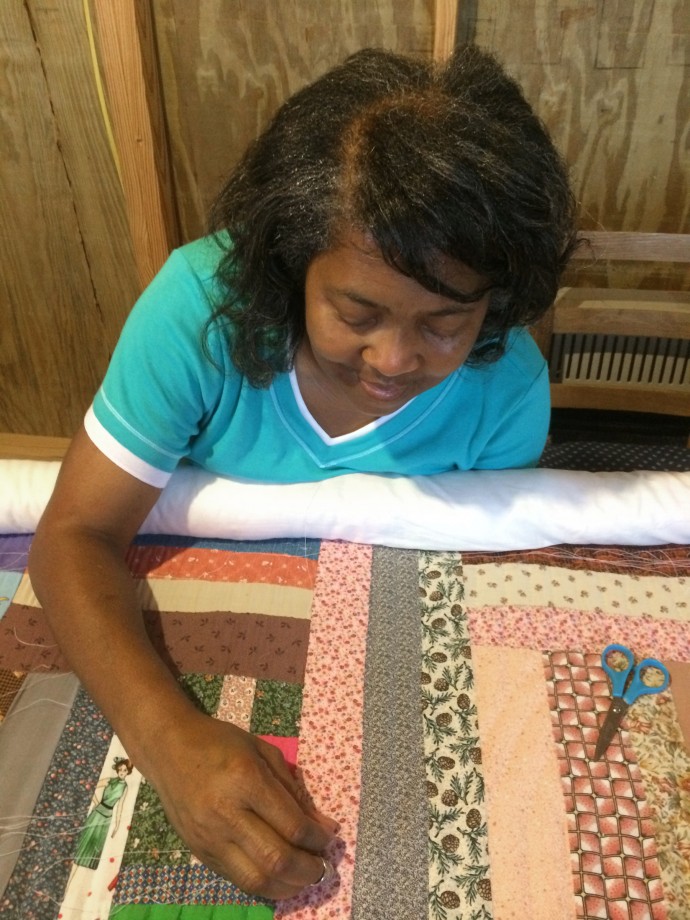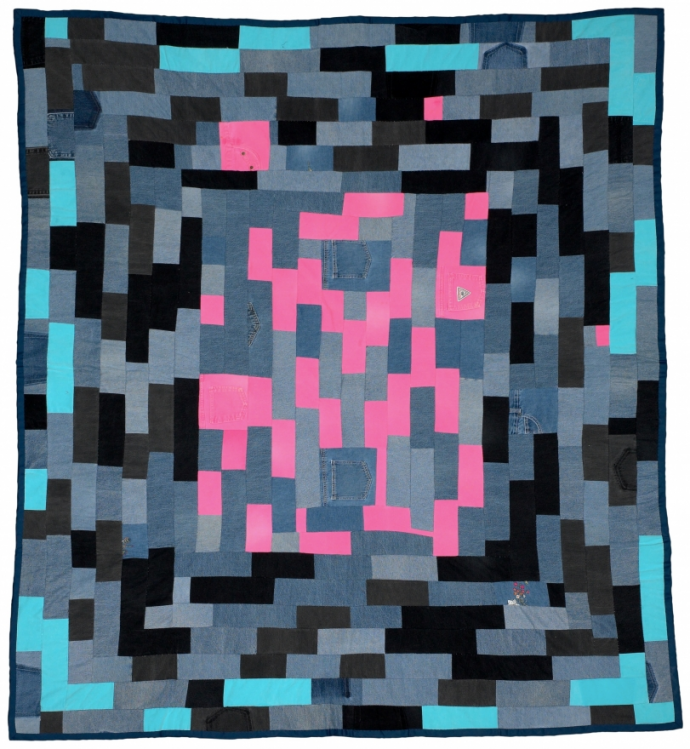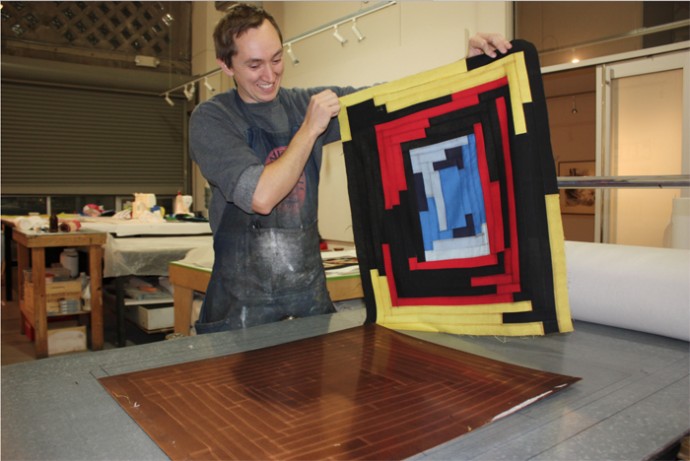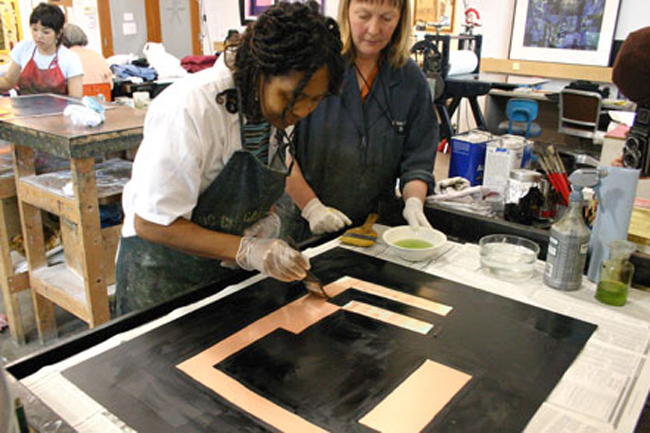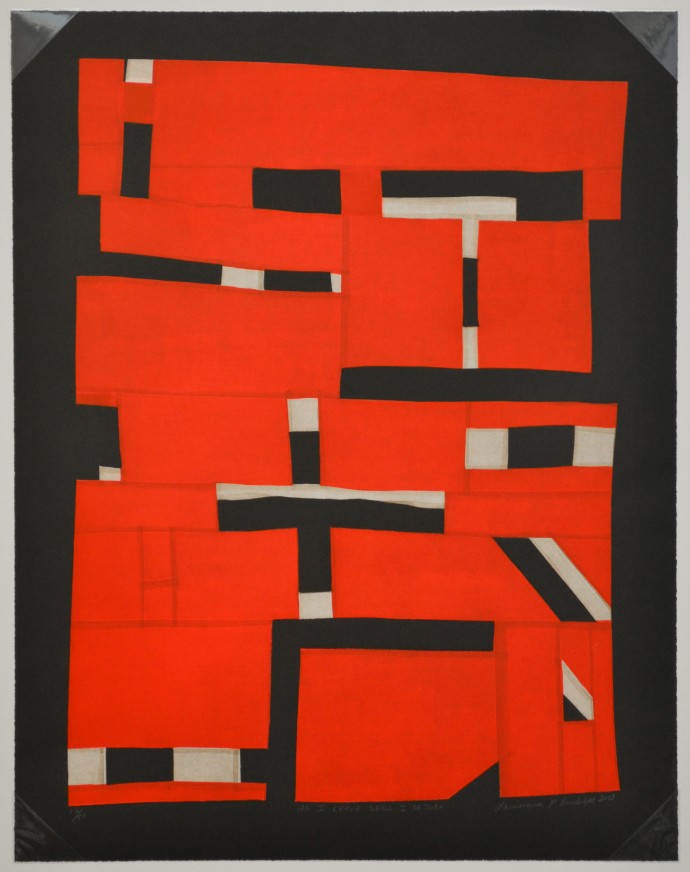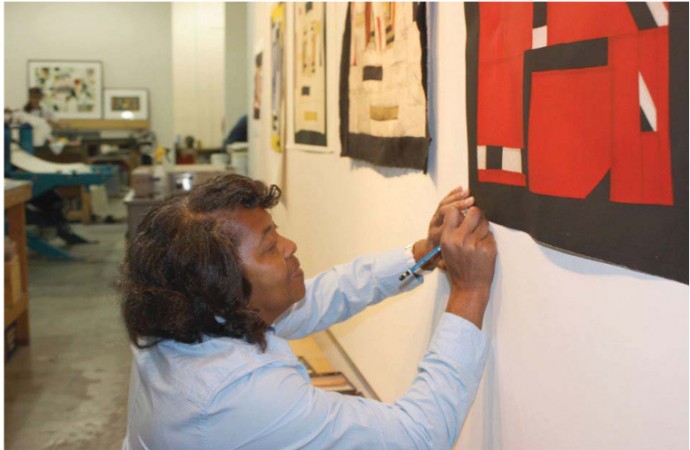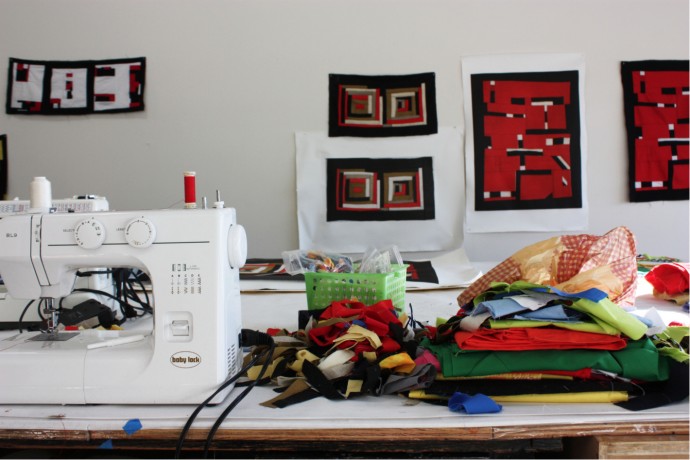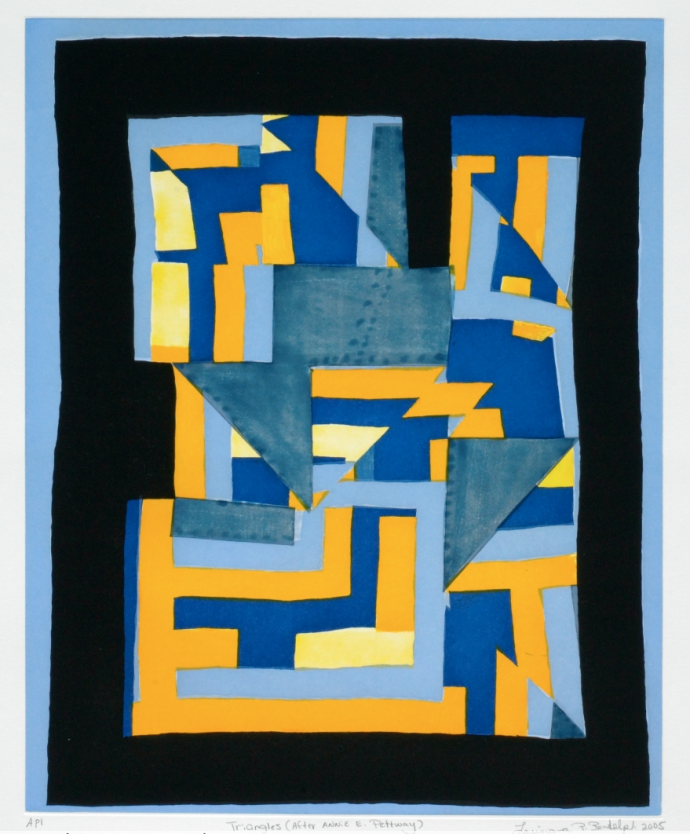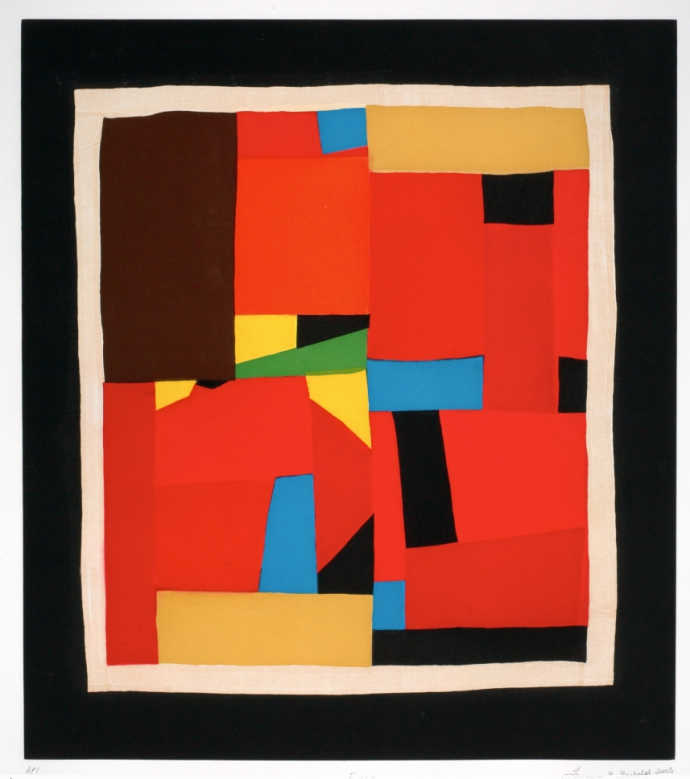Louisiana Bendolph: From Cloth to Paper
Introduction
This article was first published in the Fall 2015 edition of the Newsletter for the Print, Drawing & Photograph Society of the Baltimore Museum of Art. Members of the society who have already read this article may enjoy seeing in color the two images from the Newsletter. I’ve also added a number of images of Bendolph at work at Paulson Bott Press, in Berkeley, CA, where she made her prints. All images of Bendolph’s quilts and prints are used with the permission of the artist. And, of course, this version allows readers direct access to online links.
Quilter Turns Printmaker
A piece of the Gee’s Bend quilt story has arrived at the BMA, thanks to the acquisition of As I Leave Shall I Return, a 2013 color aquatint and softground etching by Louisiana Bendolph, printed at Paulson Bott Press in Berkeley, CA. It is one of three prints purchased by the Museum from vendors at this year’s Baltimore Contemporary Print Fair [March, 2015].
Ann Shafer, Associate Curator of Prints, Drawings & Photographs, showed me these prints (plus the matrix for one of them) last spring. I immediately gravitated to the Bendolph because it is the aesthetic kin to the quilts that I fell in love with at a 2004 exhibition—The Quilts of Gee’s Bend—at the Corcoran Gallery of Art in Washington, DC.
It was the same traveling exhibition that caught the eye of Pam Paulson, founder and master printer of the Paulson Bott Press. “I first saw the quilts at the Whitney [Museum of American Art] in winter 2002-3,” Paulson told me via an email exchange. “I was vacationing in New York with my family, and we were all blown away by the work. I bought the book that accompanied the show and took it home to show everyone. My father who was 85 at the time remarked, ‘Why don’t you make prints with them?’ He was a brilliant man.”
Louisiana Bendolph quilting a quilt top designed by her mother, Rita Mae Pettway. (Photo by Louisiana’s daughter Alleeanna Bendolph.)
Neither Pam nor I would have known about Gee’s Bend quilts had it not been for the collecting genius of William Arnett. He started patronizing self-taught African-American artists across the South in the 1970s. In 2010 he established the Souls Grown Deep Foundation, which now owns works in depth by over 150 artists. The foundation was the catalyst for The Quilts of Gee’s Bend exhibition, co-organized by the Museum of Fine Arts, Houston, and the Whitney.
The Souls Grown Deep website—http://soulsgrowndeep.org/—is an excellent source on Gee’s Bend—its history, quilt styles, names of quilters and examples of their work, and in some cases in-depth biographies of quilters. Louisiana Bendolph submitted a lengthy autobiography. (See http://soulsgrowndeep.org/artist/louisiana-p-bendolph)
Gee’s Bend is a black community isolated by a u-shaped bend in the Alabama River. To quote the Souls Grown Deep website: “The seven hundred or so inhabitants of this small, rural community are mostly descendants of slaves, for generations they worked the fields belonging to the local Pettway plantation. Quiltmakers there have produced countless patchwork masterpieces beginning as far back as the mid-nineteenth century, with the oldest existing examples dating from the 1920s.”
As was common among former enslaved communities, the Pettway name lives on at Gee’s Bend. Louisiana Bendolph’s mother is Rita Mae Pettway. From her autobiography, Bendolph says, “I was twelve years old when I made my first quilt. … I can’t remember what colors it was, but it was made from scraps that were left over from clothes that Rabbit [my mother] had made for the kids.”
For years Bendolph upheld the Gee’s Bend quilting tradition, but with marriage in 1980 and the children that followed, she soon quit quilting. Her reasoning was practical. She wrote that she “stopped because I had plenty of quilts to keep my family warm.”
TOP: Louisiana Bendolph, Housetop Variation, 2004, denim and twill quilt, 81″ x 74″, Collection of Souls Grown Deep Foundation
BOTTOM: Louisiana Bendolph, Housetop Variation, 2003, cotton quilt, 90″ x 81″, Collection of Souls Grown Deep Foundation
But her interest in quilting revived in 2002, when she accompanied her mother for the opening of the Gee’s Bend exhibition in Houston. (Thanks to Pam Paulson, I was able to speak to and later exchange emails with Louisana Bendolph.) “When I walked into the Houston Museum of Art,” she wrote me, “and saw my great-grandmother’s quilt hanging on the wall; it was such a great feeling. The only thing I could think of was my great-grandmother and how proud and honored she would have been.
“Art basically tells a story and that’s exactly what the quilts do. The quilts are inspired by pain, suffering, heartache, happiness, joy, and excitement. My great-grandmother would be proud to see that it is being passed down from generation to generation.”
Up to then, she said, “I had stopped quilting because I didn’t see the need for quilts anymore. When I saw my great-grandmother’s quilt and the other women’s quilts, whom I had known my whole life, hanging in the museum, it inspired me. On my way home I kept seeing visions of quilts, and they would not leave me alone, so I went back to sewing, telling my stories. The more I traveled and talked about my work, I began to realize that it was my inheritance, something that has been passed down from my great-grandmother to three generations and who was I to say no to that.”
Meanwhile, Pam Paulson wanted to convince a few Gee’s Bend quilters to come to Berkeley and make prints. She wrote me: “We tried to connect with the quilters through various contacts in the South but hit dead ends until I called Radcliffe Bailey [an Atlanta artist] to ask him if he’d drive with me to Gee’s Bend to meet the quilters. He said yes. The next evening he attended a dinner and coincidentally sat next to Matt Arnett [William Arnett’s son]. He told Matt of my interest, and Matt called me. We talked almost daily for a week and got to know each other. Matt was protective of the ladies and wanted to make sure we were OK. Matt suggested which quilters would be best to work with and who were willing to travel.”
When Matt Arnett asked Louisiana and Mary Lee Bendolph, her mother-in-law, to go to Paulson Bott Press in California, Louisiana told me that she agreed, “not even knowing what prints were at the time. I wanted to go to a new place; so I said yes. To this day I am grateful that William Arnett saw art in our work and continues to take it places I never thought it would go. A man with a vision, thank you.”
I asked Paulson: What did you do to create an environment for Mary Lee and Louisiana Bendolph to work up designs for prints? She responded: “Mary Lee and Louisiana are hard workers. We set the studio up with sewing machines and scissors. We wanted them to create designs in fabric for the prints, realizing the sewn lines’ uniqueness could only be translated that way.
“The transition to working in the studio was pretty seamless. The quilters plugged right into working. The first day we went out to buy fabric at both Goodwill and a fabric store. We purchased cart loads of old clothes that we took back to the studio and started ripping apart. Working side by side, everyone relaxed into the rhythm of making things.”
So the Bendolphs started to make small quilt tops to serve as maquettes for their prints. Then the printers at Paulson Bott placed maquettes atop plates covered in a softground matrix and ran the plates through a press. “Softground seemed to be the most direct way to work,” wrote Paulson. “The elegant line was captured along with the varying fabric textures.” She provided a link to her online newsletter that describes the process: http://paulsonbottpress.com/wp-content/uploads/Bendolph-2014.pdf
Top: Master Printer Sam Carr-Prindle pulls the quilt maquette off of the softground. It was the first step in transferring the design onto the plate. (Photo courtesy of Paulson Bott Press)
Bottom: Louisiana Bendolph is spitbiting to one of her intaglio plates with Pam Paulson looking on. (Photo courtesy of Paulson Bott Press)
So what was it like becoming a printmaker, I asked Bendolph. “At first, it was hard trying to make a piece that would look complete on such a small scale.” And how was it to work publicly on a print as opposed to privately at home on a quilt? “At first I was afraid of what they would think about my work and how I would respond when I had to make decisions about my work, because using paint instead of fabric is a lot different. It was great to learn new things, and people were willing to help you realize things that you can do.”
As Bendolph made prints at Paulson Bott in 2005, 2007, and 2013, Paulson watched her change: “Each time we worked together Louisiana has grown as an artist and has slowly accepted herself as an artist. Initially we created prints that looked very close to the actual quilt, color-wise. In Lou’s most recent project she departed from the color dramatically in one for the prints.” Another Paulson Bott Press online newsletter discusses Bendolph’s growth as a printmaker: pulsonbottpress.com/wp-content/uploads/Bendolph-2005-OKTP-Mary-Lee.pdf
Or in Bendolph’s words: “I don’t think that the way I make prints has really changed, but I have started to see that you can add a new color and take out a color—which is really great because seeing that come together is pretty amazing. Plus it is a lot simpler than taking the whole quilt apart to change a color.”
She mentioned that the design for the print the BMA bought didn’t come easily. This is how she recalled resolving it: “The print As I Leave Shall I Return was inspired by a plane ride to California. There was a soldier on board and another who had passed away. As I watched them carry the coffin off the plane, it made me think of just basic life. How so many times we take people for granted
by saying or doing some mean things and not knowing if we will return to see them again?”
Top: Louisiana Bendolph, As I Leave Shall I Return, 2013, color softground etching with aquatint. Somerset white paper, paper and image size 23 x 32″ Edition 50. (Photo courtesy of the Baltimore Museum of Art)
Bottom: Louisiana signing a copy of As I Leave Shall I Return. (Photo courtesy of Paulson Bott Press)
The quilt maquette (partly cut off) and a proof print for As I Leave Shall I Return hang on the wall on the right. On the wall in the center is the maquette and proof print for Housetop Block at My Mother’s Knees, another Louisiana Bendolph color softground etching with aquatint and spitbite aquatint. (Photo courtesy of Paulson Bott Press)
ADDITIONAL LINKS
On YouTube:
• Quilters of Gee’s Bend Alabama: https://www.youtube.com/watch?v=BUO7GGoH5hc
• INDUSTRY episode: Gees Bend Quilters & Joe Cunningham segment: https://www.youtube.com/watch?v=i6kcRkapFKk
• The Women of Gee’s Bend (singing): https://www.youtube.com/watch?v=ky5SWyuakp0
On Public Radio:
The Quilts of Gee’s Bend on “Talk of the Nation”: http://www.npr.org/templates/story/story.php?storyId=970364
The Artistry Of Rural Alabama Meets The Art World on North Carolina Public Radio: http://wunc.org/post/artistry-rural-alabama-meets-art-world#stream/0
Two of Louisiana’s first prints made at Paulson Bott Press
TOP: Louisiana Bendolph, Triangles (After Annie E. Pettway), 2005, color softground etching with aquatint and spitbite aquatint. Image size: 20 ½” x 16 ½”; paper size: 29 ½” x 24 ½.” Edition of 50 (Collection of Souls Grown Deep Foundation)
Bottom: Louisiana Bendolph, First 300, 2005, color softground etching with aquatint. Image size: 31″ x 27″; paper size: 40 ½” x 35.” (Collection of Souls Grown Deep Foundation)
Trackback URL: https://www.scottponemone.com/louisiana-bendolph-from-cloth-to-paper/trackback/



